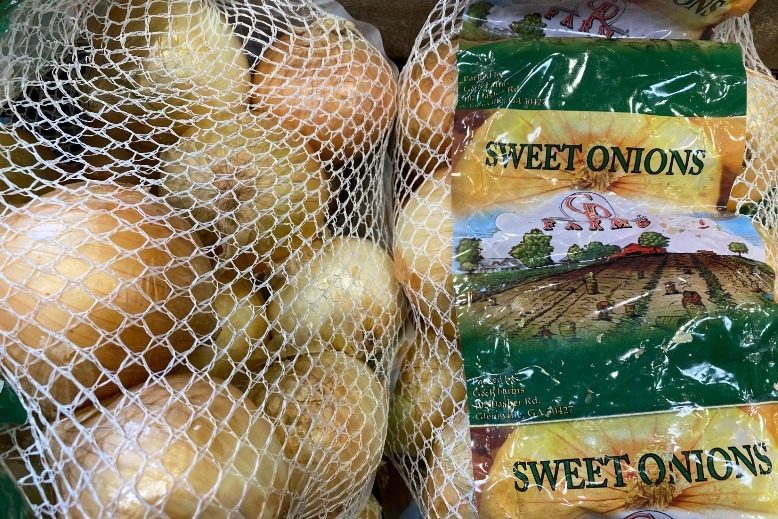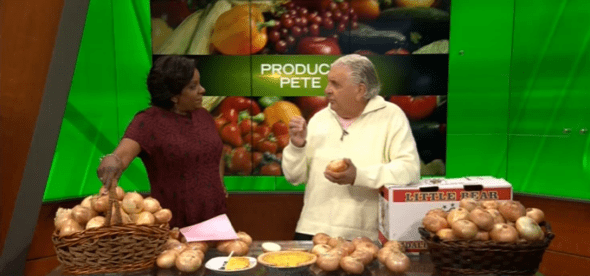
It’s Vidalia onion season in southeast Georgia, and if you’ve never tasted this variety, you don’t know what you’re missing! New Jersey soil is often credited for the freshness and flavor of its tomatoes—Georgia can make a similar claim when it comes to its unique, homespun Vidalia onions.
The harvest of Vidalia onions, which usually starts at the end of April, is a little late this year, so you should start to see them in your stores right about now. This unique Georgia-grown onion, known as “The World’s Sweetie,” receives its delicious flavor from the sandy, low-sulfur soil and mild temperatures found only in the 20-county production area of southern Georgia. About 10,000 acres of Vidalia onions were planted for the 2021 season, and, according to Vidalia Onion Committee Chairman Aries Haygood, “we’re anticipating a good harvest, and consumers across the country should have an ample supply throughout the season.”
Because they’re a bit of a specialty item with limited production, Vidalia onions are typically higher-priced than most other onions—a reality which was initially hard for my father to swallow when he was running our family business, Napolitano’s Produce in Bergenfield, in the 1950s and ’60s. “An onion is an onion,” he used to say to me, “so why do I have to charge my customers double the price?” I would explain that it was because they were sweet and wouldn’t make other mothers’ eyes tear like my mom’s eyes did when she sliced onions (as a kid, I hated seeing my beloved mom cry for any reason, so the price of Vidalias meant nothing to me). As time went on, Pop came around, and we sold those sweet Vidalia onions to many a grateful customer. To this day, whenever I see Vidalias in the stores, it brings back those childhood memories.
THE SCOOP ON VIDALIAS
Accidentally discovered by farmer Moses Coleman in Toombs County, Georgia, in the 1930s (and named Georgia’s official state vegetable in 1990), Vidalia onions are the sweetest onion in the world. Years ago, you had to travel to southern Georgia to get these hand-planted, hand-harvested delicacies each spring, but now you can get them in just about every grocery store in America. Just because they’re available doesn’t always mean they’re sweet, however. As a spring onion, Vidalias are harvested early, so they’re always sweet in April and May, but because they’re refrigerated in order to remain available in stores all summer and fall, they can lose flavor over time, so they’ll be at their peak sweetness from April to June. In addition, while most onions make your eyes tear, Vidalias are tear-free because, when they’re sliced, their cells release enzymes that break down the sulphur compounds.
MORE FUN FACTS ABOUT VIDALIA ONIONS
- Vidalias are named after the town they’re grown in—Vidalia, Georgia.
- The Vidalia Onion Act, passed in 1986, established that only sweet onions grown in 20 South Georgia counties from a distinctive Granex seed and packed and sold on or after the official pack date each year could officially be called Vidalia onions.
- The 1,300-square-foot Vidalia Onion Museum in Vidalia, GA, is filled with exhibits that highlight the sweet onion’s economic, cultural and culinary significance.
- Annual Vidalia sales now exceed $300 million and represent over 60% of the nation’s sweet onion crop.
- Onions like Vidalias have been used as elixirs throughout history. For example, believing that onions enhanced strength, ancient Egyptians fed them to workers building the pyramids, while early American settlers used wild onions to repel insects and treat colds, coughs and breathing problems. Russians used onions as an antiseptic for their wounds during World War II.
- Sweet onions like Vidalias have cancer-fighting properties and are a good source of vitamin C.
SELECTION AND STORAGE

Produce Pete shares the magic of Vidalia onions with anchorwoman Pat Battle during a segment on NBC Weekend Today in New York. Courtesy of Pete Napolitano/NBC
A fresh Vidalia onion has a light, golden-brown skin and white interior. Its shape is rounded on the bottom and somewhat flat on the top or stem end. With today’s use of a controlled atmosphere or cold storage, retailers can prevent onions from turning hot and spoiling after being picked. Once in the store, select onions that have a fresh smell, and are intact and free of soft spots or bruises.
The water content in Vidalia onions is much higher than in other onion varieties. This contributes to the Vidalia’s sweet taste, but it also shortens their shelf life and makes them more susceptible to bruising. As a result, a great place to store Vidalias is in the vegetable bin in the refrigerator, where, wrapped individually in paper towels, they can potentially keep for months. The sulfites in an onion are the elements that produce the onion’s pungent odor and heat (and make your eyes tear), so by storing them separately in the fridge or in another cool, dry place, the sugar will remain in the onions, and the sulfites will take longer to take hold. Don’t store your onions with potatoes, however, as this can make the onions go bad faster.
PREPARATION
Onions are extremely versatile and can be baked, boiled, fried or sautéed for use in countless recipes, or eaten raw in salads and on sandwiches. They can also be frozen and used later for cooking purposes. While their low sulfite content minimizes the degree to which Vidalia onions make your eyes tear when you cut them, chilling onions before you cut them can also reduce tearing.
My wife Bette’s Vidalia onion pie inevitably makes its way onto our dinner table around this time of year, and we always look forward to it in our house. I know it will hit the sweet spot for you, too!
Bette’s Very Vidalia Sweet Onion Pie
INGREDIENTS:
- 1½ cups buttery crackers, finely crushed
- 6 tablespoons (¾ stick) unsalted butter, room temperature
- 2 cups Vidalia onions, thinly sliced
- ¾ cup whole milk
- 2 eggs
- ¾ teaspoon salt
- Pepper to taste
- ¾ cup packed sharp cheddar cheese, grated
- Paprika to taste
- Chopped fresh parsley to taste
INSTRUCTIONS:
Preheat oven to 350 degrees. Mix the crackers and 4 tablespoons of butter in a bowl until well-blended. Press the mixture on the bottom and one inch up the sides of an 8-inch pie plate or baking dish. Melt the remaining 2 tablespoons of butter in a heavy, medium skillet over medium heat. Add onions and sauté until tender; about 12 minutes. Arrange onions in the cracker crust. Beat milk, eggs and salt in a medium bowl until blended; season with pepper, and pour the egg mixture over the onions in the crust. Sprinkle cheese and paprika over the filling, and bake the pie until a knife inserted into the center comes out clean; about 35 minutes. Garnish with parsley, serve and enjoy!
About “Produce Pete” Napolitano
With over 65 years of experience in the produce industry, New Jersey’s own “Produce Pete” Napolitano is a renowned fruit and vegetable expert, author and television personality who’s appeared on a highly popular segment on NBC’s Weekend Today in New York, broadcast every Saturday morning for over 27 years. For more information, visit Pete’s website.
About Susan Bloom
A contributor to New Jersey Monthly and a variety of other well-known local and national publications, Susan Bloom is an award-winning, New Jersey–based freelance writer who covers topics ranging from health and lifestyle to business, food and more. She’s collaborated with “Produce Pete” on a broad range of articles for more than a decade.



